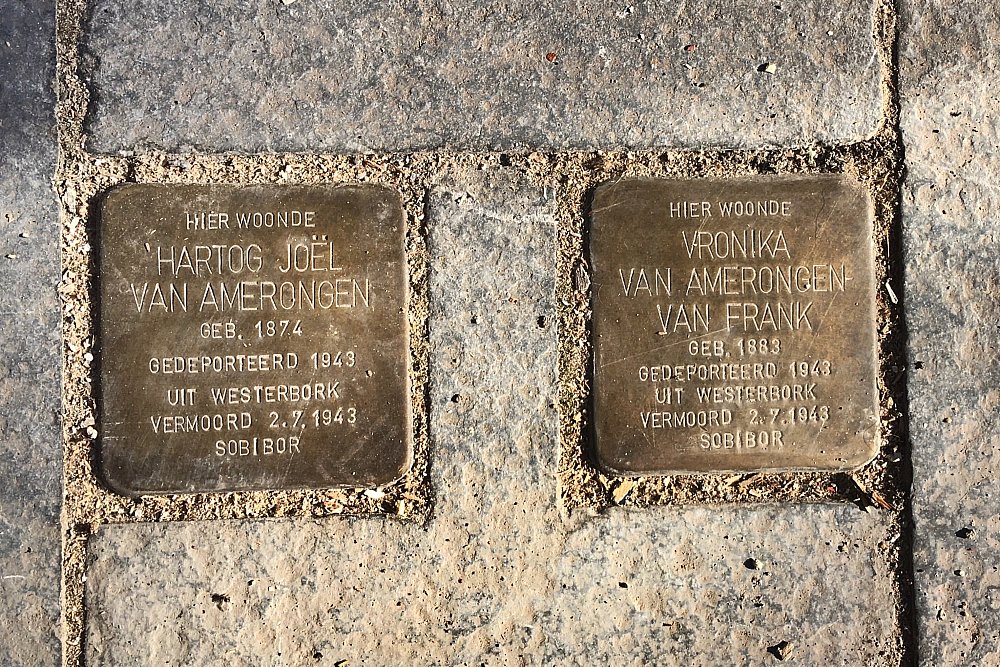Stumbling Stones Haarlemmerstraat 233
These small, brass memorial plaques (stolpersteine or stumbling stones) commemorate:
* Hartog Joël van Amerongen, born 1874, deported 1943 from Westerbork, murdered 2 July1943, Sobibor.
* Vronika van Amerongen-van Frank, born 1883, deported 1943 from Westerbork, murdered 2 July1943, Sobibor.
Background
Hartog Joël van Amerongen and Vronika van Frank married and had 3 children. The parents owned a jewelry store in Leiden, selling gold and silver items. In February 1941, Vronika yelled at two boys from an NSB (Dutch national-socialist movement) family, and the boys were insulted. They were later injured in violent political riots. The connection between their injuries and Vronika’s words was not seen, but the boys’ mother complained to Heinz Staffin, the local group leader of the Leiden NSDAP (National Socialist German Workers’ Party). Vronika was sentenced to 3 months in prison. Steffin arranged to become the trustee of the jewelry store and shared in the sale of the goods. The store was closed in December 1941.
A year and a half later, Hartog and Vronika were deported via Westerbork to Sobibor and murdered there on the same day. He was 68; she 60.
Their three children all survived the war, living into their 70s or 80s.
"Stolpersteine" is an art project for Europe by Gunter Demnig to commemorate victims of National Socialism (Nazism). Stolpersteine (stumbling stones) are small, 10x10cm brass plaques placed in the pavement in front of the last voluntary residence of (mostly Jewish) victims who were murdered by the Nazis. Each plaque is engraved with the victim’s name, date of birth, and place (mostly a concentration camp) and date of death. By doing this, Gunter Demnig gives an individual memorial to each victim. One stone, one name, one person. He cites the Talmud: "A human being is forgotten only when his or her name is forgotten."
Do you have more information about this location? Inform us!
Source
- Text: Anne Palmer
- Photos: Johan Bolhuis
- Leiden4045.nl: Amerongen-Van Frank, familie Van
- Joods Monument
- Geni.com
- Stolpersteine.eu
Nearby
Museum
- Museum of Ethnology - Leiden
- Visitor Center Valkenburg Airport - Valkenburg (Katwijk)
- Fire Brigade Museum Wassenaar - Wassenaar
Point of interest
- Police Office Leiden - Leiden
- Office National Socialist Student Front - Leiden
- Academy Building Leiden University - Leiden
Monument
- Memorial Brick Liberation of the Netherlands - Leiden
- Memorial Hartebrug-Church Leiden - Leiden
- Memorial Franciscan Monks Leiden - Leiden
Cemetery
- Dutch War Grave Municipal Cemetery Leiderdorp - Leiderdorp
- Dutch War Graves Municipal Cemetery Rhijnhof Leiden - Leiden
- Dutch War Grave Roman Catholic Cemetery Oegstgeest - Oegstgeest
Remembrance Stone
- Stumbling Stones Breestraat 161 - Leiden
- Stumbling Stone Rapenburg 38 - Leiden
- Stumbling Stones Kloksteeg 3 - Leiden
Fortification
- Atlantikwall - FluWa Leiderdorp - Leiderdorp
- Widerstandsnest 251, VF Observationpost Katwijk - Katwijk aan Zee
- Bunker Noordwijk WN232 - Noordwijk





